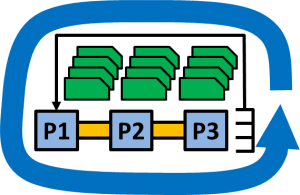 This post describes a second accurate way to detect the bottleneck in manufacturing systems, based on the precise times a process is waiting or active. The method is highly accurate, not only giving the likelihoods of different processes being the (temporary) bottleneck, but also estimating the improvement of the entire system capacity if the bottleneck(s) are improved. It is also possible to observe the shifting of these bottlenecks over time. The method was developed by me during my time at the Toyota Central R&D Laboratories in Japan. See below for a complete list of posts on this series on bottlenecks.
This post describes a second accurate way to detect the bottleneck in manufacturing systems, based on the precise times a process is waiting or active. The method is highly accurate, not only giving the likelihoods of different processes being the (temporary) bottleneck, but also estimating the improvement of the entire system capacity if the bottleneck(s) are improved. It is also possible to observe the shifting of these bottlenecks over time. The method was developed by me during my time at the Toyota Central R&D Laboratories in Japan. See below for a complete list of posts on this series on bottlenecks.
Christoph Roser
Common Bottleneck Detection Methods that do NOT work!
 To improve your system capacity, it is a must to find and improve your bottleneck. However, finding the bottleneck is difficult. Most methods used in industry fail at finding the bottleneck. As discussed in my previous post on Shifting Bottlenecks, this is mostly due to bottlenecks being dynamic and frequently shifting from one process to the next. In this post we will look at common bottleneck detection methods used in industry. More importantly, we will find out more about failures of bottleneck detection methods commonly used in industry. Subsequent posts look at bottleneck detection methods that actually DO work!
To improve your system capacity, it is a must to find and improve your bottleneck. However, finding the bottleneck is difficult. Most methods used in industry fail at finding the bottleneck. As discussed in my previous post on Shifting Bottlenecks, this is mostly due to bottlenecks being dynamic and frequently shifting from one process to the next. In this post we will look at common bottleneck detection methods used in industry. More importantly, we will find out more about failures of bottleneck detection methods commonly used in industry. Subsequent posts look at bottleneck detection methods that actually DO work!
About Shifting Bottlenecks
![]() Improving system capacity requires you to find the bottleneck; however, bottleneck detection is a tricky business. The main problem is that most bottlenecks are not static, but move around. In this post we will look at the behavior of bottlenecks on the shop floor. This is the first post in a series of posts on bottleneck detection. Subsequent posts will look at the flaws of commonly used methods to find the bottleneck and describe two new reliable methods for finding the bottleneck on the shop floor.
Improving system capacity requires you to find the bottleneck; however, bottleneck detection is a tricky business. The main problem is that most bottlenecks are not static, but move around. In this post we will look at the behavior of bottlenecks on the shop floor. This is the first post in a series of posts on bottleneck detection. Subsequent posts will look at the flaws of commonly used methods to find the bottleneck and describe two new reliable methods for finding the bottleneck on the shop floor.
Culture of Quality – A Comparison of Toyota and GM Recalls
Toyota Employee Relationship Crisis and Countermeasures 1990’s
 Toyota has developed what is probably the finest production system in the world, the Toyota Production System. There is general consensus in the rest of the world that its methods and philosophies can significantly improve efficiency and quality, to the point that anything Toyota does is admired and copied. Some practitioners seem to wear rose-colored glasses when talking about Toyota. However, like any company, Toyota does have its fair share of problems and mishaps to deal with, from the 1950 near collapse, to the US gas pedal recalls during 2009–2011. This post will discuss the employee relationship crisis at Toyota around 1990 and Toyota’s countermeasures.
Toyota has developed what is probably the finest production system in the world, the Toyota Production System. There is general consensus in the rest of the world that its methods and philosophies can significantly improve efficiency and quality, to the point that anything Toyota does is admired and copied. Some practitioners seem to wear rose-colored glasses when talking about Toyota. However, like any company, Toyota does have its fair share of problems and mishaps to deal with, from the 1950 near collapse, to the US gas pedal recalls during 2009–2011. This post will discuss the employee relationship crisis at Toyota around 1990 and Toyota’s countermeasures.
How Many Kanbans? – Estimation Approach and Maintenance

In my previous two posts, I described how to calculate the number of kanbans (Post 1 and Post 2). However, this calculation is complex, and the result is nothing more than a very rough estimate. Hence my preferred method for determining the number of kanbans is, broadly speaking, “just take enough, and then see if you can reduce them.” In this post, I would like to explain this approach and also discuss how and when to update the number of kanbans.
How Many Kanbans? – The Kanban Formula, Part 2

This is the second post on kanban calculation (if possible, please read the first post on kanban calculation first). There are two possible approaches. First, you can calculate the number of kanbans using a kanban formula (due to its length, split into a first post and this second post). Alternatively, you can estimate the number of kanbans and adjust the system as it is running (as shown in a third post).
How Many Kanbans? – The Kanban Formula, Part 1

One frequent and tricky question when designing a pull system is to determine how many kanbans to use in the system. There are two possible approaches. First, you can calculate the number of kanbans using a kanban formula. Due to the length of the process, I have broken this into two posts (For the second part click here). Alternatively, you can estimate the number of kanbans and adjust the system as it is running (as shown in a third post).

